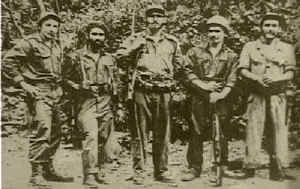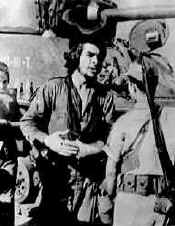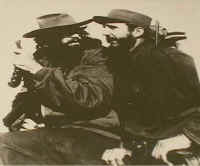|
| |

Part 1: The Struggle for Power

Dr. Fidel Castro Ruz was born in 1926 in the Oriente province.
As a young student he became involved in political protest. After Fulgencio Batista had
led a coup to overthrow the government, Castro as a lawyer tried to have the dictatorial
government declared illegal in court; he didn't win. Later he turned to violent means to
change the corrupt government.  Castro
organized some 160 or so men to attack the Moncada military fortress and the Bayamo
barracks, in 1953, on July 26. The rebellion was crushed by the military and Castro was
captured and imprisoned. A few months later Batista released Castro in response to public
pressure, thinking him not a threat. Castro
organized some 160 or so men to attack the Moncada military fortress and the Bayamo
barracks, in 1953, on July 26. The rebellion was crushed by the military and Castro was
captured and imprisoned. A few months later Batista released Castro in response to public
pressure, thinking him not a threat.
Castro left for Mexico and organized a small band of 85 men as a
fighting force of radical social revolutionists. They called themselves the July 26
movement after the date of Castro's previous offensive. They returned by boat to Cuba in
1956 and were nearly destroyed by the Cuban military. Only 12 survived, including Castro
and an Argentinean Marxist doctor named Ernesto "Che" Guevara. For two years
this small band fought guerilla warfare in the Sierra Maestra mountains.Their group grew
in number and popularity. Castro promised change, including a non-corrupt government, free
elections, improved educational systems, and health care. In 1957 he released a
"Declaration of Sierra Maestra," a declaration for the movement:
Immediate freedom for all political, civil, and military
prisoners.
Absolute guarantee of freedom of information, of the spoken
word and written press and of all the individual and political rights guaranteed by the
constitution.
Designation of provisional mayors in all the municipalities
prior to consultation with the civic institutions of the locality.
Suppression of speculation in all its forms and adoption of
measures to increase the efficiency of all organisms of the state.
Democratization of labor policy, promotion of free elections
in all unions and federations in industries.
Establishment of a civil service.
Immediate start of a campaign against illiteracy and for civic
education, exalting the duties and rights which the citizen has in relation to society and
the fatherland.
Establishment of the foundations of agrarian reform, tending
to the distribution of barren lands. Conversion of all the lessees- planters, partners,
squatters who possess small parcels of land (private or public) with prior indemnification
to the former owners- into proprietors.
Adoption of a sound financial policy that safeguards the
stability of Cuba's money and tends to use the credit of the nation in productive works.
Acceleration of the process of industrialization and the
creation of new jobs.
Castro's Declaration demanded an end to foreign
interference in Cuban affairs, the repudiation of any type of military junta, the
separation of the army from politics, and the holding of general
elections under the terms of the 1940 Constitution. army from politics, and the holding of general
elections under the terms of the 1940 Constitution.
There were several attempts to replace Batista. In March 1958,
the Catholic Church in Cuba appealed to Batista to make way for a neutral government which
could restore civil peace. Two attempts to stride Batista in 1957 and 1958 failed. There
were also attempts to assassinate him. In summer of 1958 the Batista forces made their
last major effort to destroy the rebels, and failed.
Towards the end of 1958, the US began an arms embargo against
the Batista regime. Before the embargo, the U.S. was considered friendly with  Batista, and it was when his regime clearly began to fall apart that the
U.S. started the Embargo, which was interpreted as support for Fidel Castro. The U.S.
ceased its supply of arms, but it still dominated Cuba's sugar industry and other economic
interests. Batista fled to the Dominican Republic on Jan. 1, 1959 to escape the rebellion
that had swept the country. This left Cuba for Castro's revolutionary forces which took
control of Havana on January 8, 1959. Fidel Castro took full control of Cuba within a few
hours after Batista fled. About a month and a half later Castro became prime minister. Batista, and it was when his regime clearly began to fall apart that the
U.S. started the Embargo, which was interpreted as support for Fidel Castro. The U.S.
ceased its supply of arms, but it still dominated Cuba's sugar industry and other economic
interests. Batista fled to the Dominican Republic on Jan. 1, 1959 to escape the rebellion
that had swept the country. This left Cuba for Castro's revolutionary forces which took
control of Havana on January 8, 1959. Fidel Castro took full control of Cuba within a few
hours after Batista fled. About a month and a half later Castro became prime minister.

Pictures on
this page: the heros of the revolution--Fidel and his soldiers, Che, and Camilo.
|